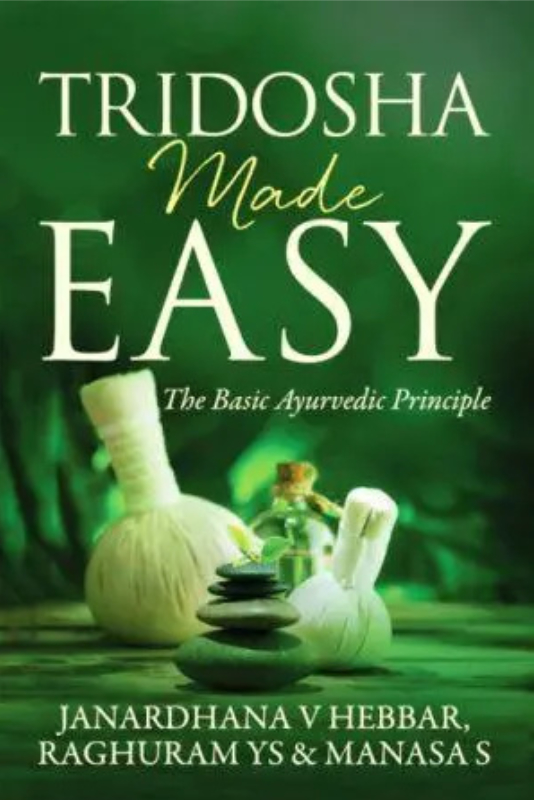Tridosha Made Easy Book
Introduction

Special features
The book Tridosha Made Easy offers:
- The basic understanding of Tridosha in an easy language
Functions, types, qualities and places of Tridosha - Tridosha’s role in the functioning of the immune system, endocrine system, etc.
- Tridosha’s role in maintaining health and causing disease
Tridosha Prakriti – body type - Diseases and symptoms caused by Tridosha imbalance
- Diet and lifestyle to balance Doshas
- Healthy daily regimen and relationship with Vata, Pitta and Kapha
Association of Doshas with Ama - Concept of Avarana and Gata Vata and their easy understanding
5 Free Video classes: Send your purchase receipt to [email protected] and get 5 Ayurveda video classes for free
List of Chapters
1.Easy Introduction to Ayurveda
2. Tridosha Theory in Ayurveda
3. Vata Dosha – Introduction 4. Pitta Dosha – Introduction 5. Kapha Dosha – Introduction
6. Interaction of Vata with Pitta and Kapha
7. Correlation of Tridosha with Nature
8. Qualities of Vata, Pitta and Kapha
9. Relationship between Doshas and Basic Elements (Pancha Mahabhuta)
10. Dhatu and Mala – Tissues and Waste Products
11. Tridosha Places in the Body
Functions of
12. Vata Dosha 13. Pitta Dosha 14. Kapha Dosha
15. Tridosha Dominance in Lifespan, Day – Night and Digestion
16. Anatomical Classification of Body on Basis of Doshas
17. Relationship of Doshas with Seasons
18. Types of Doshas and Their Functions
Location, Functions, Imbalance Symptoms, Treatment of
19. Prana Vata 20. Udana Vata 21. Vyana Vata 22. Samana Vata 23. Apana Vata
24. Pachaka Pitta 25. Ranjaka Pitta 26. Sadhaka Pitta 27. Alochaka Pitta 28. Bhrajaka Pitta
29. Avalambaka Kapha 30. Kledaka Kapha 31. Bodhaka Kapha 32. Tarpaka Kapha 33. Shleshaka Kapha
34. Coordination between Doshas in the Body
Relationship Between
35. Tissues and Doshas 36. Doshas and Sense Organs
37. Doshas and Digestive Fire 38. Doshas and Tastes
39. Formation of Doshas in Different Stages of Digestion
40. Effect of Vipaka (Post Digestion Taste Change) on Doshas
41. Involvement of Doshas in Organ Formation
Role of Doshas in
42. Blood Circulation, Nutrition and Breathing 43. Gastro Intestinal Tract
44. Reproductive System 45. Excretory System 46. Endocrine System
47. Doshas and Ayurvedic Immunology
48. Doshas and Musculo-Skeletal System
49. Doshas and Channels of Circulation
50. Role of Vata Dosha in Speech and Voice
51. Blood as the Fourth Dosha – Controversy and Discussion
52. Trisutra of Ayurveda – Causes, Symptoms and Treatment
53. Relationship Between Doshas and Sattva, Rajas and Tamas
54. Tridosha as Substance and Energy
55. Dosha Prakriti Theory and Modern Genetics
Diet and Lifestyle Advice for
456. Vata Body Type Person 57. Pitta Dosha Body Type
58. Kapha Dosha Body Type
59. Doshas Acting as Tissues and Waste Products
60. Dosha Paka Lakshanas – Symptoms of Digestion of Doshas
61. Contributory Factors for a Disease – Ayurvedic View Point
62. Dosha and Vikriti, the Pathology of Diseases
63. Cardinal Symptoms of Doshas in Diseases
64. Dosha Imbalance in Relation to Prakriti
65. Decrease, Balance and Increase of Doshas – Kshaya, Sthana, Vriddhi
Symptoms of
66. Vata Increase 67. Vata Decrease
68. Pitta Increase 69. Pitta Decrease
70. Kapha Increase 71. Kapha Decrease
72. Relationship of Doshas with Nidana Panchakas
73. Stage-wise Disease Manifestation – Shat Kriya Kala
74. Dosha Chaya, Kopa, Shamana – Aggravation and Auto-Pacification
75. Understanding of Dosha Qualities in Disease Process
76. Types of Dosha Imbalance
77. Doshas in Gut, Tissues, Vital Points, Bones and Joints
78. Upward, Downward, Lateral Dosha Movements
79. Movement of Doshas From Tissues to Visceral Organs
80. Normal and Abnormal Dosha Imbalance
81. Independent and Dependent Dosha Imbalance
82. Involvement of Multiple Doshas in the Disease Process
83. Ashayapakarsha – Displacement of Pitta and Kapha Dosha by Vata
84. Samanyaja and Nanatmaja Vyadhi – Specific and General Dosha Disorders
85. Vata Increase Due to Tissue Depletion – Dhatu Kshaya
86. Vata Disorders – Definition, Causes, Symptoms and Treatment
87. Gata Vata – Vitiated Vata in Tissues, Visceral Organs
88. Treatment of Aggravated Doshas
89. Ayurvedic Panchakarma Treatment – Introduction, Benefits, Dosha Relation
90. Oil, Ghee and Honey – Best Remedies to Balance Vata, Pitta and Kapha
91. Healthy Daily Regimen and Dosha Relation
Diet for
92. Vata Balance 93. Pitta Balance 94. Kapha Balance
Balancing two Dosha together
95. Vata and Pitta 96. Pitta and Kapha 97. Kapha and Vata
98. External Treatments for Tridosha Balance
Yogasanas for
99. Vata Balance 100. Pitta Balance 101. Kapha Balance
102. Vata, Pitta and Kapha Balancing Pranayamas
103. Avarana – Blockage of Channels
104. Doshas Associated with Ama – Symptoms, Treatment
105. Sama and Nirama Vata – Symptoms, Treatment
106. Sama and Nirama Pitta – Symptoms, Treatment
107. Sama and Nirama Kapha – Symptoms, Treatment
108. Treatment for Ama and Saama Conditions

